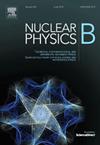全息重建分数动作宇宙学的现象学见解:宇宙动力学,热力学和状态检测器诊断
IF 2.8
3区 物理与天体物理
Q2 PHYSICS, PARTICLES & FIELDS
引用次数: 0
摘要
在这项工作中,我们使用广义红外(IR)截止作为重建工具,通过分数作用宇宙学(FAC)研究全息暗能量的动力学。我们构建了一个宇宙学模型,通过使用分数微积分来分析引力作用,自然地考虑了宇宙后期加速等重要特征。我们详细研究了能量条件、热力学行为和状态方程(EoS)参数,特别注意了广义第二定律(GSL)。我们发现模型参数n和弛豫时间τ都对宇宙演化有重要影响。根据状态检测器的诊断,该模型非常符合典型的ΛCDM情景,但在某些情况下,它也显示出类似Chaplygin气体行为的模式。我们的发现证明了FAC框架在模拟宇宙演化方面的适应性和实用性。在Nojiri-Odintsov方法的激励下,我们建议扩展当前的模型,以统一后期加速和早期暴胀作为未来的方向。为了更好地理解相变并加强全息重建FAC的宇宙学意义,我们还建议将IR截止推广到Nojiri-Odintsov型。本文章由计算机程序翻译,如有差异,请以英文原文为准。
Phenomenological insights into holographically reconstructed fractional action cosmology: Cosmic dynamics, thermodynamics, and statefinder diagnostics
In this work, we use generalised infrared (IR) cutoffs as a reconstruction tool to investigate the dynamics of holographic dark energy through Fractional Action Cosmology (FAC). We construct a cosmological model that naturally takes into account important features like the universe's late-time acceleration by using fractional calculus to analyse the gravitational action. We investigate the energy conditions, thermodynamic behaviour, and equation of state (EoS) parameter in detail, with special attention to the Generalised Second Law (GSL). We discover that the model parameter n and the relaxation time τ both have important effects on cosmic evolution. According to statefinder diagnostics, the model fits the typical ΛCDM scenario quite well, but it also exhibits patterns that, in certain circumstances, resemble the behaviour of Chaplygin gas. Our findings demonstrate the FAC framework's adaptability and practicality in simulating cosmic evolution. Motivated by the Nojiri-Odintsov approach, we suggest expanding the current model to unify late-time acceleration and early-time inflation as a future direction. In order to gain a better understanding of phase transitions and to reinforce the cosmological significance of holographically reconstructed FAC, we also propose to generalize the IR cut-off to the Nojiri-Odintsov type.
求助全文
通过发布文献求助,成功后即可免费获取论文全文。
去求助
来源期刊

Nuclear Physics B
物理-物理:粒子与场物理
CiteScore
5.50
自引率
7.10%
发文量
302
审稿时长
1 months
期刊介绍:
Nuclear Physics B focuses on the domain of high energy physics, quantum field theory, statistical systems, and mathematical physics, and includes four main sections: high energy physics - phenomenology, high energy physics - theory, high energy physics - experiment, and quantum field theory, statistical systems, and mathematical physics. The emphasis is on original research papers (Frontiers Articles or Full Length Articles), but Review Articles are also welcome.
 求助内容:
求助内容: 应助结果提醒方式:
应助结果提醒方式:


